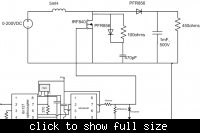sabu31
Advanced Member level 1

Hi
I had made a dc-dc boost converter. I/p 150V, O/p 375V , load=450ohms. The gate driver is IXDN504PI. However when i tested the converter at the rated voltage the switch blew off after 2-3 min. The heat sink was just warm and not very hot. The switch i used was IRF840 (500V,8A).There was no ringing effect, the voltage spike during turn off was 25 volts for 200ns. The output diode also got damaged as well as the gate driver IC. I had used back to back zeners(15v) at gate terminal for protection. I have two questions
1) What should be the switch rating(or safety margin) so that it can be used for o/p 400V at nearly 350W continuously say for 8-10hrs.Is IRF840 enough?
2) What should i do for the driver protection in case the switch gets damaged. I came across article where back to back zener was used for protection , however here the zener was not effective.
Thanking you
I had made a dc-dc boost converter. I/p 150V, O/p 375V , load=450ohms. The gate driver is IXDN504PI. However when i tested the converter at the rated voltage the switch blew off after 2-3 min. The heat sink was just warm and not very hot. The switch i used was IRF840 (500V,8A).There was no ringing effect, the voltage spike during turn off was 25 volts for 200ns. The output diode also got damaged as well as the gate driver IC. I had used back to back zeners(15v) at gate terminal for protection. I have two questions
1) What should be the switch rating(or safety margin) so that it can be used for o/p 400V at nearly 350W continuously say for 8-10hrs.Is IRF840 enough?
2) What should i do for the driver protection in case the switch gets damaged. I came across article where back to back zener was used for protection , however here the zener was not effective.
Thanking you



